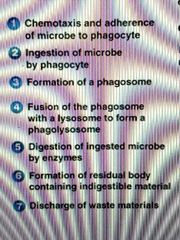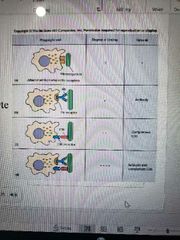![]()
![]()
![]()
Use LEFT and RIGHT arrow keys to navigate between flashcards;
Use UP and DOWN arrow keys to flip the card;
H to show hint;
A reads text to speech;
43 Cards in this Set
- Front
- Back
- 3rd side (hint)
|
True or false) Innate resistance is another term for immunity. |
False, innate resistance is resistance due to a condition for the survival of host or an expressed trait that prevents a specific pathogen to from infecting that specific host
|
|
|
|
What are examples of innate resistance? |
-lack of correct chemical receptors, in humans, needed for a specific pathogen attachment -incompatibe temperature or pH for pathogen survival |
|
|
|
Describe innate defenses. |
-present from birth (genetic defenses) -Nonspecific (target large groups of organisms) |
|
|
|
What terms are used to describe when protection against a pathogen is induced only after exposure; specific to the agent? |
Acquired immunity / Specific adaptive |
|
|
|
Other than it being a barrier, name some other key features that make skin protective? |
-outside layer is dead cells making viruses unable to penetrate (need living cell to replicate) - dry, cool, low pH -chemicals: salt, fatty acids, lysozyme |
|
|
|
Which cells are beneath the surface of the skin that are defensins? |
Lymphoid cells |
|
|
|
Tears, saliva, vaginal secretions all caontain what enzyme? |
Lysozyme |
|
|
|
What is the mode of action for lysozyme? |
Attacks peptidoglycan in some bacterial cell walls. |
|
|
|
Portals of entry contain what important features that DO NOT protect against pathogens? |
Internal lining: -moist - warm - living cells |
|
|
|
True or false) Mucus membranes contain many defenses. |
True |
|
|
|
What stimulates antiviral proteins? |
Interferons |
Not virus specific |
|
|
Transferrin and lactoferrin are what kind of defense? What do they do? |
Chemical defense. Binds to iron. |
|
|
|
What are the 2 components to the blood? |
Plasma and cells |
|
|
|
This is the fluid part of the blood, what is it composed of? |
Plasma - complement - antibodies |
|
|
|
The non fluid parts of blood contain: |
Erythrocytes (RBC) Platelets - clotting Leukocytes (WBC) |
|
|
|
These are the series of protiens, in the blood, waiting to be stimulated to protectively react. |
Complement |
|
|
|
What chain of events happen when complement is activated? |
1. Formation of membrane attack complex - cell lysis 2. Opsonization- increase phagocytosis 3. Recruit phagocytes for inflammatory response |
F.O.R. |
|
|
Formation of membrane attack complex results in? |
Cell lysis |
|
|
|
Opsonization is: |
When there is an increase in phagocytosis. |
|
|
|
Classical and alternative pathways initiate what? |
Complement |
|
|
|
The classical pathway contains a |
Ab-ag complex |
|
|
|
This activates complement by directly binding of C to pathogen. |
Alternative pathway |
|
|
|
True or false) Bacteria with capsules on them can prevent complement activation. Explain. |
True, there is no access to the cell wall surface |
|
|
|
If a bacteria have surface lipid - carbohydrate in their cell wall, this prevents: |
MAC formation |
Bacteria evade complement |
|
|
Enzymatic digestion of C5a is an example of: |
How bacteria evade complement |
|
|
|
What is diapedesis? Which cells can perform this process? |
The ability to make their way through blood vessels to the site of infection. Especially when the permeability of blood vessels is increased due to an inflammatory response.
Neutrophils and eosinophils |
|
|
|
True or false) Neutrophils and eosinophils cannot phagocytose |
False |
|
|
|
List leukocytes: |
Basophils, eosinophils, Neutrophils, lymphocytes, monocytes |
WBC |
|
|
True or False) Neutrophils are the most involved in specific immunity |
False, this is describing lymphocytes |
|
|
|
What do monocytes mature into? |
Macrophages and dendritic cells |
|
|
|
True or false) All macrophages phagocytos locally |
False, they may phag. throughout the body & fixed macrophages phag. within specific organ |
|
|
|
What are some examples of fixed macrophages from ppt? |
Microglia- CNS Alveolar macrophages - lungs Küpffer cells - liver |
|
|
|
These cells are often the first phagocytic cell at/near surfaces that can bring pathogen to lymph nodes to initiate immune response. |
Dendritic cells |
|
|
|
Describe the phases in phagocytosis. |

|
|
|
|
What is a respiratory or oxidative burst? What results? |
Mechanism of destruction Produces reactive oxygen and nitrogen compounds -superoxide -hydrogen peroxide -hypochlorite -nitric oxide (NO) |
|
|
|
What is NET? |

Neutrophil extracellular traps -mechanism for trapping pathogens outside the cell |
|
|
|
These are antibody or other substance which binds to foreign microorganisms or cells making them more susceptible to phagocytosis |

Opsonins |
|
|
|
True or false) NK cells kill bacterial infected cells and tumors & dont kill normal body cells |
False, they kill virally infected cells |
|
|
|
How to NK cells kill? |
Natural killer (NK) cells secrete proteins that form pores (perforin) and deposit enzymes (granzymes) into target that induce apoptosis. |
|
|
|
NK cells bind to |
Ubiquitous molecules & MHC class 1 molecules |
|
|
|
The lack of which molecule induces an attack by the NK cell? |
MHC class 1 molecules |
|
|
|
Why would a cell not have an MHC class 1 molecules on the surface of the cell, inducing a NK cells? |
A lot of viruses interfere with the MHC class 1 from being able to bring molecules to the surface of the cell |
|
|
|
True or false) Inflammation is typically a localized infection |
True |
|

